Eugene Bullard
| Eugene Jacques Bullard | |
|---|---|
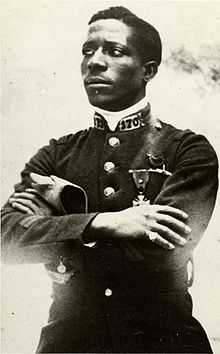 Bullard, as a French army corporal | |
| Nickname(s) | Black Swallow of Death |
| Born |
October 9, 1895 Columbus, Georgia, United States |
| Died |
October 12, 1961 (aged 66) New York City, United States |
| Buried at | Flushing Cemetery (40°45′6″N 73°47′58″W / 40.75167°N 73.79944°WCoordinates: 40°45′6″N 73°47′58″W / 40.75167°N 73.79944°W) |
| Allegiance |
|
| Service/branch |
|
| Years of service | 1914–1919, 1940 |
| Battles/wars |
World War I World War II |
| Awards |
Légion d'honneur Médaille militaire Croix de Guerre Croix de Guerre Croix du combattant volontaire 1914-1918 Insigne des blessés militaires Médaille Interalliée 1914–1918 Médaille commémorative de la guerre 1914-1918 Médaille commémorative de la guerre 1939–1945 Insignia for the Military Wounded |
Eugene Jacques Bullard (9 October 1895 – 12 October 1961), the first African-American military pilot, was born Eugene James Bullard.[1] His life has been surrounded by many legends.[2] Bullard was one of only the few black combat pilots in World War I, like Ahmet Ali Çelikten.
Early life
Bullard was born in Columbus, Georgia, one of the 10 children of William O. Bullard, nicknamed "Big Chief Ox", and his wife Josephine Thomas, a Creek Indian.[3] He was a student at Twenty-eighth Street School in 1901-1906, where he learned to read and write.[4] As a teenager, Eugene Bullard stowed away on a ship bound for Scotland, seeking to escape racial discrimination (he later claimed to have witnessed his father's narrow escape from lynching). Bullard arrived at Aberdeen before making his way south to Glasgow. He became a boxer in Paris and also worked in a music hall.
World War I experience

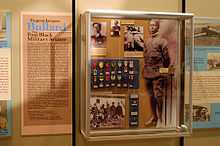
On a visit to Paris, Bullard decided to settle in France. At the outbreak of World War I, according to his personnel file at the French Ministry of Defense, he enlisted on October 19, 1914 in the 1st Regiment of Foreign Legion (1er Régiment étranger)[5] since volunteers from overseas in 1914 were allowed to serve only in the French colonial troops.[6]
Ground combat
As a machine gunner, Bullard was in 1915 in combat on the Somme front in Picardy: in May and June 1915 at Artois, and in the fall of the same year took part in a second Champagne offensive (25 September - 6 November 1915) along the Meuse river.[7][8] The 1st and the 2nd Foreign legion regiments were fighting as a part of the 1st Moroccan brigade (1re Brigade Marocaine) of the 1st Moroccan division (la Division Marocaine). Formed by Hubert Lyautey, a Resident-General of Morocco, at the outbreak of WWI, it was a mix of the Metropolitan and Colonial French troops, including legionnaires, zouaves and tirailleurs.[9] Towards the end of the war, the 1st Moroccan division became one of the most decorated unit in the French army.[10]
The Foreign Legion suffered high casualties in 1915. It started the year with 21,887 soldiers, NCOs and officers, and ended with 10,683.[11] As a result, the Foreign Legion units fighting on the Western front were put in reserve for reinforcement and reorganization. On November 11, 1915, 3,316 survivors from the 1st and the 2nd Etranger were merged into one unit - the Marching Regiment of Foreign Legion (Le régiment de marche de la légion étrangère), which in 1920 became the 3rd Regiment (3e régiment étranger d'infanterie) of the French Foreign Legion.
As for Americans and other volunteers, they were allowed to transfer to the Metropolitan French Army units, including the 170th Line Infantry Regiment. 170th had a reputation of crack troops and was nicknamed Les Hirondelles de la Mort, or The Swallows of Death.[12] Bullard opted to serve in the 170th Infantry Regiment to which fact testifies his collar military insignia. In the beginning of 1916, 170th Infantry along with the 48th Infantry Division (48e division d'infanterie) to which it belonged, was sent to Verdun.
Family request
After hearing about the horrors of the trench war in France, Bullard's father wrote to the U.S. Secretary of State pleading for help in order to bring his son back home. He said that Eugene was born in October 1895, not 1894, and simply added himself a year when he enlisted. However, the French government officials decided that Bullard was old enough to enlist.[7]
Aviation
As a part of the 170th Infantry, Bullard fought and was seriously wounded in March 1916 during the Battle of Verdun.[7][13] After recovering from his wounds, Bullard volunteered on October 2, 1916 to join the French Air Service (Aéronautique Militaire)[14] as an air gunner, and went through training at the Aerial Gunnery School in Cazaux, Gironde.[5] Later, he went through initial flight training at Châteauroux and Avord and received his pilot's license number 6950 from the Aéro-Club de France on May 5, 1917.[5][7] Like many other American aviators, Bullard wanted to join the famous aero squadron Escadrille Americaine N.124, the Lafayette Escadrille, but after enrolling 38 American pilots in spring and summer of 1916, it stopped accepting new flyers. Therefore, after receiving more training at Avord, Bullard on November 15, 1916,[15] joined 269 American aviators at the Lafayette Flying Corps[16] of the French Air Service, which was a designation rather than a unit.[17] American volunteers flew with French pilots in different pursuit and bomber/reconnaissance aero squadrons on the Western Front. Edmund L. Gros, who facilitated the incorporation of American pilots in the French Air Service, listed in the October 1917 issue of Flying, an official publication of the Aero Club of America, Bullard's name in the member roster of the Lafayette Flying Corps.[18]
On June 28, 1917 Bullard was promoted to the rank of corporal.[5] On August 27, 1917 he was assigned to the Escadrille N.93 based at Beauzée-sur-Aire south of Verdun, where he stayed till September 13.[19] The squadron was equipped with Nieuport and Spad aircraft that bore a flying duck as its squadron insignia. Bullard's service record also includes the aero squadron N.85 (Escadrille SPA 85), September 13, 1917 - November 11, 1917, which had a bull insignia.[15][20] He took part in about twenty combat missions, and is sometimes credited with shooting down one or two German aircraft (sources differ).[8] However, the French authorities did not confirm Bullard's victories.[21]
When the United States entered the war, the United States Army Air Service convened a medical board to recruit Americans serving in the Lafayette Flying Corps to the Air Service of the American Expeditionary Forces. Bullard went through the medical examination, but was not called in since only white pilots were allowed to serve. A time later, while being on short break from duty in Paris, Bullard allegedly got into a fight with a French officer and was punished by being transferred to the service battalion of the 170th in January 1918.[8] As a noncombatant, he served past the Armistice being finally discharged on October 24, 1919.[7]
After the war
For his World War I service Bullard was awarded the Croix de Guerre, Médaille militaire, Croix du combattant volontaire 1914–1918, and Médaille de Verdun, among others.[8][13] Following his discharge, Bullard returned to Paris.
In Paris
In Paris, Bullard found employment as a drummer and a nightclub manager at "Le Grand Duc" and eventually became the owner of his own nightclub, "L'Escadrille". He married Marcelle Straumann from a wealthy family in 1923, but the marriage ended in divorce in 1935, with Bullard gaining custody of their two surviving children, daughters Jacqueline and Lolita.[22] As a popular jazz venue, "Le Grand Duc" gained him many famous friends, including Josephine Baker, Louis Armstrong, Langston Hughes and French flying ace Charles Nungesser. When World War II began in September 1939, Bullard, who spoke German, agreed to a request from the French government to spy on Germans frequenting his nightclub.
After the German invasion of France in May 1940, Bullard fled from Paris with his daughters. He volunteered with the 51st Infantry defending Orléans when he met an officer whom he knew from fighting at Verdun.[7] He was wounded in the fighting but was able to escape to neutral Spain, and in July 1940 he returned to the United States.
In New York City
Bullard spent some time in a New York hospital and never fully recovered from his wound. Moreover, he found the fame he enjoyed in France had not followed him to the United States. He worked as a perfume salesman, a security guard, and as an interpreter for Louis Armstrong, but his back injury severely restricted him. He attempted to regain his nightclub in Paris, but his property had been destroyed during the war. He received a financial settlement from the French government, which he used to buy an apartment in Harlem, New York City.
Peekskill Riots
In 1949, a concert held by black entertainer and activist Paul Robeson in Peekskill, New York to benefit the Civil Rights Congress resulted in the Peekskill Riots. These were caused in part by members of the local Veterans of Foreign Wars and American Legion chapters, who considered Robeson a communist sympathizer.[23] The concert was scheduled to take place on August 27 in Lakeland Acres, north of Peekskill. Before Robeson arrived, however, a mob attacked the concert-goers with baseball bats and stones. Thirteen people were seriously injured before police put an end to it. The concert was then postponed until September 4.[24] The re-scheduled concert took place without incident, but as concert-goers drove away, they passed through long lines of hostile locals, who threw rocks through their windshields.
Eugene Bullard was among those attacked after the concert. He was knocked to the ground and beaten by an angry mob, which included members of the state and local law enforcement. The attack was captured on film and can be seen in the 1970s documentary The Tallest Tree in Our Forest and the Oscar winning documentary narrated by Sidney Poitier, Paul Robeson: Tribute to an Artist. None of the assailants was ever prosecuted. Graphic pictures of Eugene Bullard being beaten by two policeman, a state trooper and a concert goer were published in Susan Robeson's biography of her grandfather, The Whole World in His Hands: a Pictorial Biography of Paul Robeson.[23]
Later life

In the 1950s, Bullard was a relative stranger in his own homeland. His daughters had married, and he lived alone in his apartment, which was decorated with pictures of his famous friends and a framed case containing his fifteen French war medals. His final job was as an elevator operator at the Rockefeller Center, where his fame as the “Black Swallow of Death” was unknown.
In 1954, the French government invited Bullard to Paris to help rekindle the everlasting flame at the Tomb of the Unknown Soldier under the Arc de Triomphe. In 1959 he was made a chevalier (knight) of the Légion d'honneur. While this gained him some recognition, his last years were spent in relative obscurity and poverty in New York City.
On December 22, 1959 he was interviewed on NBC's Today Show by Dave Garroway and received hundreds of letters from viewers. Bullard wore his elevator operator uniform during the interview.
Eugene Bullard died in New York City of stomach cancer on October 12, 1961 at age 66.[1] He was buried with military honors in the French War Veterans' section of Flushing Cemetery in the New York City borough of Queens.
Legacy
Eugene Bullard received fifteen decorations from the government of France.[7] He was made a knight of the Legion of Honor, which is France's most coveted award. He was also awarded the Médaille militaire, another high military distinction in France.[25]
In 1972, Bullard's exploits as a pilot were retold in a biography, The Black Swallow of Death.[26] Bullard is also the subject of the nonfiction young adult memoir Eugene Bullard: World's First Black Fighter Pilot by Larry Greenly.[27]
On 23 August 1994, thirty-three years after his death, and seventy-seven years to the day after the physical that should have allowed him to fly for his own country, Eugene Bullard was posthumously commissioned a Second Lieutenant in the United States Air Force.
The 2006 movie Flyboys loosely portrayed Bullard and his comrades in World War I.
In 2012-2014 the French writer Claude Ribbe wrote a book on Eugene Bullard [28] and made a TV 52' documentary.[29]
Decorations and awards

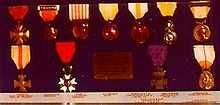
First Row -
- Legion of Honor
- Medaille Militaire
- Croix de Guerre 1914-18 with bronze star
Second Row -
Third Row -
- Victory Medal
- Verdun Medal
- Somme Medal
Fourth Row -
- World War I Commemorative Medal
- Commemorative medal for voluntary service in Free France
- World War II Commemorative Medal
Other awards -
- Voluntary Enlistment Medal (World War I)
- American Volunteers with the French Army Medal (private award)
Note - Bullard was posthumously eligible for the World War I Victory Medal (United States) as he was posthumously commissioned an officer in the United States Army with a date of rank which fell during the eligibility period of the medal.
References
- ↑ 1.0 1.1 "Eugene Bullard, Ex-Pilot, Dead. American Flew for French in '18". New York Times. October 14, 1961. Retrieved 2012-11-17.
Eugene Jacques Bullard of 10 East 116th Street, a Negro flier who was honored in France for ...
- ↑ Harris, Henry Scott (2012). All Blood Runs Red: Life and Legends of Eugene Jacques Bullard: First Black American Military Aviator. NOOK Book (eBook): eBookIt.com. ISBN 9781456612993.
- ↑ William I. Chivalette. "Corporal Eugene Jacques Bullard First Black American Fighter pilot". Air & Space Power Journal. www.airpower.maxwell.af.mil. Retrieved 2013-06-27.
- ↑ Craig Lloyd, Columbus State University (2002-11-19). "Eugene Bullard (1895-1961)". The New Georgia Encyclopedia. Retrieved 2013-06-27.
- ↑ 5.0 5.1 5.2 5.3 "Bullard James Eugene". www.memoiredeshommes.sga.defense.gouv.fr. Secrétariat Général pour l'Administration - Ministère de la Défense: Mémoire des hommes. pp. 1–2. Retrieved 2013-06-27.
- ↑ Porch, Douglas. The French Foreign Legion: a complete history of the legendary fighting force. New York: Skyhorse Publishing, 2010.
- ↑ 7.0 7.1 7.2 7.3 7.4 7.5 7.6 Carnes, Mark C. American National Biography. New York: Oxford University Press, 2005, p. 53-55.
- ↑ 8.0 8.1 8.2 8.3 Sutherland, Jonathan. African Americans at War: An Encyclopedia. Santa Barbara, Calif: ABC-CLIO, 2004, Vol. 1, p. 86-87.
- ↑ Dean, William (2010). "Morale Among French Colonial Troops On The Western Front During World War I: 1914–1918". Scientia Militaria, South African Journal of Military Studies 38 (2): 44–61. doi:10.5787/38-2-89.
- ↑ Dean, William T. (2011). "Strategic Dilemmas of Colonization: France and Morocco during the Great War". Historian 73 (4): 730–746. doi:10.1111/j.1540-6563.2011.00304.x.
- ↑ Porch, Douglas. The French Foreign Legion: a complete history of the legendary fighting force. New York: Skyhorse Publishing, 2010, p. 380.
- ↑ "Ferdinand Capdevielle". American Volunteers in the French Foreign Legion, 1914-1917. www.scuttlebuttsmallchow.com. Retrieved 1 July 2013.
- ↑ 13.0 13.1 Venzon, Anne Cipriano. The United States in the First World War: An Encyclopedia. New York: Garland Pub, 1995, p. 110.
- ↑ "French Air Service". www.theaerodrome.com. The Aerodrome: Aces and Aircraft of World War I. Retrieved 30 June 2013.
- ↑ 15.0 15.1 Hall, James Norman, Charles Nordhoff, and Edgar G. Hamilton. The Lafayette Flying Corps. Boston: Houghton Mifflin Company, 1920, Volume II, p. 324.
- ↑ Gordon, Dennis. The Lafayette Flying Corps: The American Volunteers in the French Air Service in World War One. Atglen, PA: Schiffer Pub, 2000, pp. 78-79.
- ↑ "Member Roster Volunteer American Pilots: The Lafayette Flying Corps". http://neam.org''. New England Air Museum. Retrieved 2013-06-27.
- ↑ Dr. Edmund L. Gros (October 1917). "The members of Lafayette Flying Corps". Flying 6 (9): 776.
- ↑ Sloan, James J. Wings of Honor, American Airmen in World War I: A Compilation of All United States Pilots, Observers, Gunners and Mechanics Who Flew against the Enemy in the War of 1914-1918. Atglen, Pa: Schiffer Military/Aviation History Pub, 1994, p. 64.
- ↑ Escadrille N 85 - SPA 85
- ↑ Bailey, Frank W., and Christophe Cony. French Air Service War Chronology, 1914-1918: Day-to-Day Claims and Losses by French Fighter, Bomber and Two-Seat Pilots on the Western Front. London: Grub Street, 2001.
- ↑ "Eugene Bullard". American Aviators of WWI. www.usaww1.com. Retrieved 2013-06-27.
- ↑ 23.0 23.1 Robeson, Susan. The Whole World in His Hands: A Pictorial Biography of Paul Robeson. Secaucus, N.J.: Citadel Press, 1981. Chapter 5, The Politics of Persecution, p. 181-183.
- ↑ Ford, Carin T. Paul Robeson: "I Want to Make Freedom Ring". Berkeley Heights, NJ: Enslow, 2008. Chapter 9, pp. 97–98.
- ↑ "Musée National de la Légion d'Honneur: How to research a decorated individual". www.musee-legiondhonneur.fr. Retrieved 30 June 2013.
- ↑ Carisella, P. J., and James W. Ryan. The Black Swallow of Death: The Incredible Story of Eugene Jacques Bullard, the World's First Black Combat Aviator. Boston: Marlborough House; distributed by Van Nostrand Reinhold, New York, 1972.
- ↑ Greenly, Larry (2013). Eugene Bullard: World's First Black Fighter Pilot. Montgomery: NewSouth Books. ISBN 978-1-58838-280-1.
- ↑ Eugene Bullard by Claude Ribbe (in French) Paris, Le Cherche Midi, 2012
- ↑ Eugene Bullard TV documentary Trailer
Further reading
- Carisella, P. J., and James W. Ryan. The Black Swallow of Death: The Incredible Story of Eugene Jacques Bullard, the World's First Black Combat Aviator. Boston: Marlborough House; distributed by Van Nostrand Reinhold, New York, 1972.
- Cockfield, Jamie. All Blood Runs Red . American Heritage, Vol. 46, No. 1, February–March 1995.
- Greenly, Larry W. Eugene Bullard: World's First Black Fighter Pilot. Montgomery, Alabama: NewSouth Books, 2013. ISBN 978-1-58838-280-1
- Gordon, Dennis. The Lafayette Flying Corps: The American Volunteers in the French Air Service in World War One. Atglen, PA: Schiffer Military/Aviation History Pub, 2000. ISBN 9780764311086
- Harris, Henry Scott. All Blood Runs Red: Life and Legends of Eugene Jacques Bullard: First Black American Military Aviator. NOOK Book (eBook): eBookIt, 2012. ISBN 9781456612993
- Jouineau, André. Officers and Soldiers of the French Army 1918: 1915 to Victory. Paris: Histoire & Collections, 2008.
- Lloyd, Craig. Eugene Bullard: Black Expatriate in Jazz Age Paris. Athens, Georgia: University of Georgia Press, 2000. ISBN 0-8203-2192-3
- Mason, Herbert Molloy Jr. High Flew the Falcons: The French Aces of World War I. New York: J.B. Lippincott Company, 1965.
- Ribbe, Claude Eugène Bullard: récit. Paris, Le Cherche Midi, 2012.
- Sloan, James J. Wings of Honor, American Airmen in World War I: A Compilation of All United States Pilots, Observers, Gunners and Mechanics Who Flew against the Enemy in the War of 1914-1918. Atglen, Pa: Schiffer Military/Aviation History Pub, 1994.
External links
| Wikimedia Commons has media related to Eugene Bullard. |
- Bullard James Eugene Base des Personnels de l'aéronautique militaire, Secrétariat Général pour l'Administration, Ministère de la Defence, France
- Eugene Bullard (1895-1961) New Georgia Encyclopedia
- Eugene J. Bullard Smithsonian National Air and Space Museum
- Eugene Jacques Bullard U.S. Air Force Museum
- Eugene Jacques Bullard American Volunteers in the French Foreign Legion, 1914-1917
- Eugene Jacques Bullard at Find A Grave
- Remembering Eugene Bullard
-
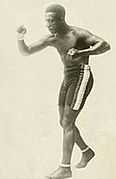
-
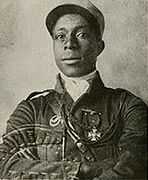
-
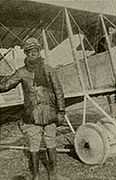
-
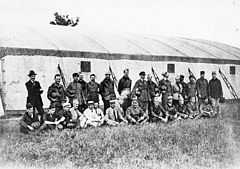
-
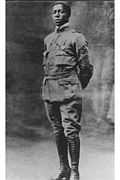
-
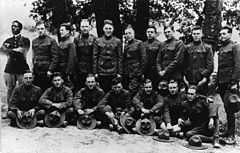
-
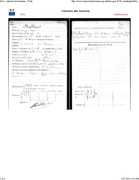
-
.jpg)
-
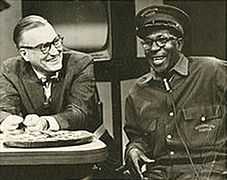
|